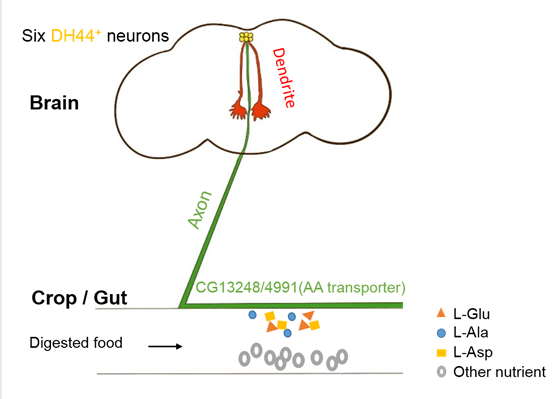Food sensing mechanism found in fruit flies
The research team led by Prof. WANG Liming of the Life Sciences Institute published an article entitled “A post-ingestive amino acid sensor that promotes food consumption in Drosophila” in the September 12 issue of the journal of Cell Research.
Proteins are the most abundant macromolecules in living organisms with a vast array of biological functions. Adequate and balanced protein intake is therefore vital for the survival, reproduction, and well-being of animals. Mammals evolve the sense of taste, but how the nervous system of fruit flies monitors amino acids is open to dispute because they lack the homolog of mammalian umami taste receptor.
WANG’s research reveals that three amino acids, L-glutamate (L-Glu), L-alanine (L-Ala) and L-aspartate (L-Asp) can considerably promote food consumption in fruit flies. This feeding-promoting effect of dietary amino acids is independent of mating experience and internal nutritional status. In vivo and ex vivo calcium imagings show that six brain neurons expressing diuretic hormone 44 (DH44) can be rapidly and directly activated by these amino acids, suggesting that these neurons are an amino acid sensor. Follow-up experiments demonstrate that DH44+ neurons mediate the effect of dietary amino acids to promote food consumption. Single-cell transcriptome analysis and immunostaining display that a putative amino acid transporter, CG13248, is enriched in DH44+ neurons. Knocking down CG13248 expression in DH44+ neurons blocks the increase in food consumption and eliminates calcium responses induced by dietary amino acids. These data identify DH44+ neuron as a key sensor to detect amino acids and to enhance food intake via a putative transporter CG13248.

These findings shed critical light on the regulation of protein homeostasis at organismal levels by the nervous system, thereby providing valuable clues to research into higher animals.